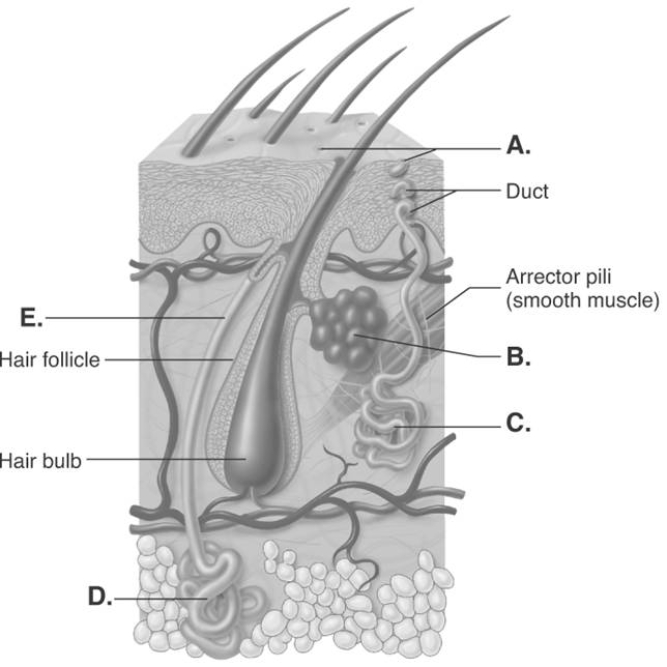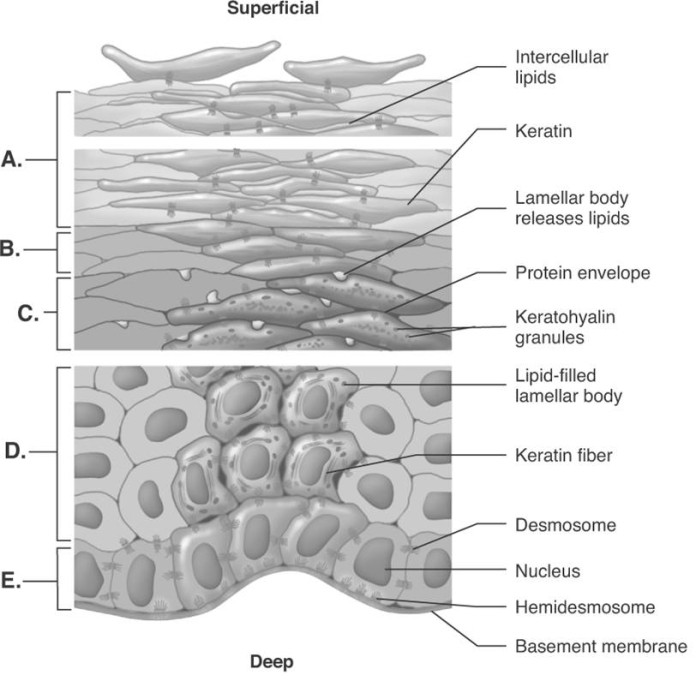A) shaft.
B) cuticle.
C) hair bulb.
D) medulla.
E) root.
G) C) and D)
Correct Answer

verified
Correct Answer
verified
Multiple Choice
Another name for a bedsore is
A) psoriasis.
B) decubitus ulcer.
C) bullae.
D) vitiligo.
E) eczema.
G) All of the above
Correct Answer

verified
Correct Answer
verified
Multiple Choice
Ringworm is an infection of the skin, hair, and nails caused by a
A) bacterium.
B) virus.
C) parasite.
D) fungus.
E) inflammation.
G) B) and E)
Correct Answer

verified
Correct Answer
verified
Multiple Choice
Which vitamin begins its synthesis in the skin exposed to ultraviolet light?
A) vitamin A
B) vitamin B
C) vitamin C
D) vitamin D
E) vitamin E
G) None of the above
Correct Answer

verified
Correct Answer
verified
Multiple Choice
The portion of a hair that protrudes above the surface of the skin is the
A) hair bulb.
B) hair root.
C) hair shaft.
D) hair follicle.
E) dermal papilla.
G) A) and E)
Correct Answer

verified
Correct Answer
verified
Multiple Choice
This is the site of fat storage in the skin.
A) epidermis
B) reticular layer
C) papillary layer
D) stretch marks
E) hypodermis
G) B) and E)
Correct Answer

verified
Correct Answer
verified
Multiple Choice
The term "stratum germinativum" is sometimes used to refer to the
A) stratum basale.
B) stratum corneum.
C) stratum spinosum.
D) stratum granulosum.
E) stratum lucidum.
G) A) and D)
Correct Answer

verified
Correct Answer
verified
Multiple Choice
The layer of epidermis that undergoes mitosis and forms new epidermal cells is the
A) stratum basale.
B) stratum granulosum.
C) stratum lucidum.
D) stratum corneum.
E) stratum dermum.
G) C) and D)
Correct Answer

verified
Correct Answer
verified
Multiple Choice
With aging, individuals tend to feel colder and usually need the thermostat in their home set higher in the winter to feel warm enough. This is probably because the elderly
A) no longer experience hot flashes at night.
B) exhibit a decrease in melanin production.
C) experience a decrease in the thickness of their subcutaneous fat layer.
D) have less blood flowing to the skin.
E) have an increase in desquamation.
G) A) and B)
Correct Answer

verified
Correct Answer
verified
Multiple Choice
A victim of an automobile accident goes into shock, which results in decreased blood flow. The victim's skin will
A) become pale.
B) have a reddish hue.
C) develop a yellow tint.
D) become bright red.
E) not change color.
G) A) and D)
Correct Answer

verified
Correct Answer
verified
Multiple Choice
 -The diagram illustrates glands of the skin. What does "E" represent?
-The diagram illustrates glands of the skin. What does "E" represent?
A) apocrine sweat gland
B) sebaceous gland
C) eccrine sweat gland
D) duct of apocrine sweat gland
E) sweat pore
G) B) and D)
Correct Answer

verified
Correct Answer
verified
Multiple Choice
Which of the following is NOT a complication of a major burn?
A) fever
B) electrolyte imbalance
C) hypermetabolic state
D) weight loss
E) decreased protein demand
G) A) and C)
Correct Answer

verified
Correct Answer
verified
Multiple Choice
Adipose tissue in the hypodermis
A) serves as a storage site for fat, which can be used for energy.
B) helps to lower body temperature.
C) provides protection against infection.
D) is absent in infants.
E) connects the dermis with the epidermis.
G) B) and D)
Correct Answer

verified
Correct Answer
verified
Multiple Choice
On coming inside from the cold, students notice that their cheeks are red. This results from
A) constriction of the blood vessels in the epidermis of the cheeks.
B) dilation of the blood vessels in the dermis of the cheeks.
C) damage to the epidermis by the cold.
D) constriction of the sweat glands in the cheeks.
E) increased permeability of superficial vessels.
G) C) and E)
Correct Answer

verified
Correct Answer
verified
Multiple Choice
This condition involves the development of white patches on the skin caused by the loss of melanocytes.
A) psoriasis
B) decubitus ulcer
C) bullae
D) vitiligo
E) eczema
G) None of the above
Correct Answer

verified
Correct Answer
verified
Multiple Choice
The epidermal layer that is present in the nail bed and the nail matrix is the
A) stratum corneum.
B) stratum lucidum.
C) stratum basale.
D) stratum spinosum.
E) stratum lunula.
G) A) and B)
Correct Answer

verified
Correct Answer
verified
Multiple Choice
 -The figure illustrates keratinization in the epidermis. What layer of the epidermis is "C"?
-The figure illustrates keratinization in the epidermis. What layer of the epidermis is "C"?
A) stratum spinosum
B) stratum corneum
C) stratum basale
D) stratum lucidum
E) stratum granulosum
G) A) and D)
Correct Answer

verified
Correct Answer
verified
Multiple Choice
Lead poisoning can be detected by doing an analysis of
A) sweat.
B) skin folds.
C) nails.
D) hair.
E) skin.
G) All of the above
Correct Answer

verified
Correct Answer
verified
Multiple Choice
Which of the following statements regarding melanin is true?
A) During pregnancy melanin production is increased.
B) Both melanocytes and keratinocytes produce melanin.
C) In Addison's disease, less melanin is produced.
D) Men produce more melanin than women.
E) Melanin is a white pigment.
G) A) and D)
Correct Answer

verified
Correct Answer
verified
Multiple Choice
Rupturing the dermis may cause these to develop.
A) epidermis
B) reticular layer
C) papillary layer
D) stretch marks
E) hypodermis
G) B) and C)
Correct Answer

verified
Correct Answer
verified
Showing 41 - 60 of 139
Related Exams